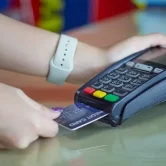The Credit Card Celebrates ‘The Big 5 0!’

Rewind for a minute – The year 1966 – England were celebrating World Cup success by beating Germany, The Beatles are top of the British singles charts for the 10th time with Paperback Writer and the BBC starts to broadcast in colour. The UK was entering a new age, and credit cards were about to be embraced.
The introduction of what is now deemed an integral part of payments for many businesses was deemed unsightly by some. It was a little plastic card, just over 7cm long and 5cm wide that slipped comfortably into most people’s wallets or purses.
The credit card was introduced on the 29th June 1966 issued by Barclays and was replicated on the Bank America Card that had been issued a couple of years earlier. Back in 1966, this simple little piece of plastic was seen as an instrument of liberation.
Fast forward 50 years, and more than 32 million of us now own a credit card, spending more than £16 billion a month and then a few weeks later, become despondent as the monthly bill arrives.
A famous newspaper advertising campaign was launched at the time to tie in with the launch and adopted a simple slogan “Barclaycard makes shopping simpler for everyone.”
Since the launch of the credit card 50 years ago, concerns have been raised that many people have now lost sight of saving and self discipline. Some feel we live in a society that constantly needs to shop and spend, with many obsessed with having the latest technological gadgets and fashions. A society in need of instant gratification.
With the value of the pound dropping as this blog goes live and desperate concerns over the economy with a post-Brexit economic downturn predicted by financial experts, this could result in millions of individuals and families falling deeper into the red.
Indeed, back in late June, the UK’s financial watchdog, the Financial Conduct Authority, stated that nearly 9 per cent of cardholders have balances that would take them more than a decade to repay.
The idea of credit was not invented in 1966. For decades, many British families had previously bought goods on home finance more commonly known as ‘on tick’ from door-to-door salesmen and local businesses.
The launch of the credit card in 1966 wasn’t without controversy. Barclays sent out over 23 million application forms to potential customers across the UK, but they also sent out a million of credit cards to existing customers, whether they had asked for them or not, a practice that would now be deemed illegal, but the weakness in the regulatory set up meant Barclays got away with it.
The introduction of contactless purchases has seen a sharp increase in the use of credit cards and contactless is now the UK’s fastest growing payment method, growing every month. According to the UK Cards Association as of July 2016, there are a total of 92.1 m contactless cards in circulation and these contactless cards are split between debit (64.7m) and credit / charge cards (27.4m).
Statistically the UK are among the worst savers in Europe, typically saving barely 8 per cent of what we earn, compared with 17 per cent in Germany, 15 per cent in Spain and almost 20 per cent in France; to put it bluntly, the UK has lost any sense of how to live within its means.
To put that figure into context, The Chinese saving rate is roughly 47 per cent — a figure that speaks volumes about the vastly different priorities of greedy, complacent Britain and busy, booming China.
So here’s to the next 50 years of credit card payments, and the ever improving changes that come with it.
Let us know your thoughts on the matter





